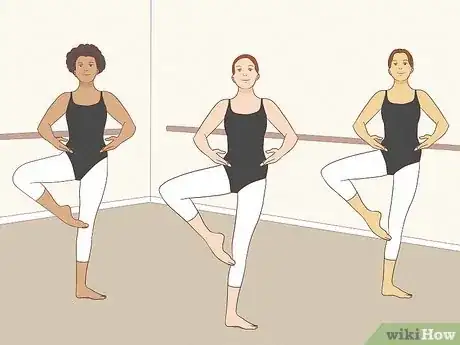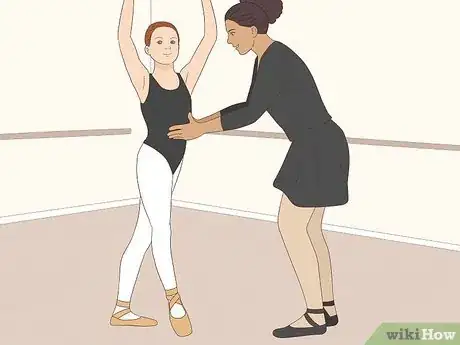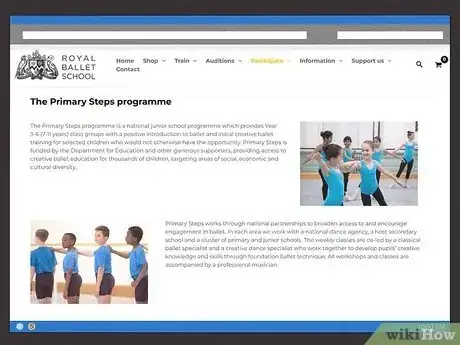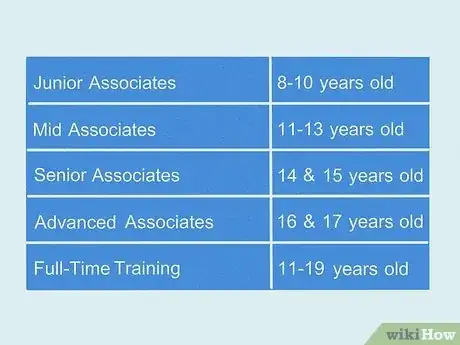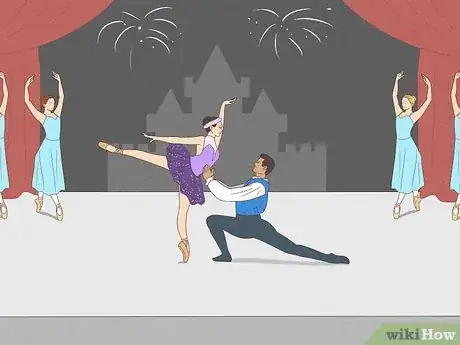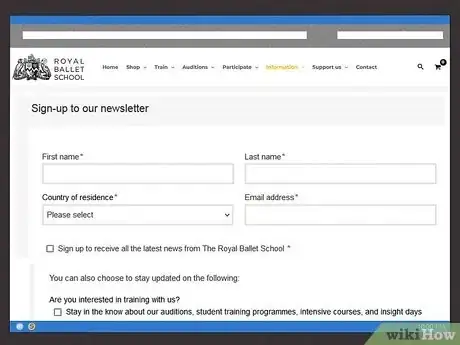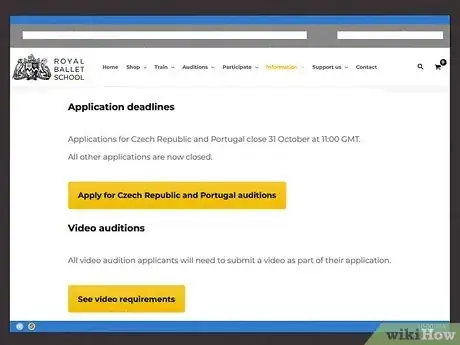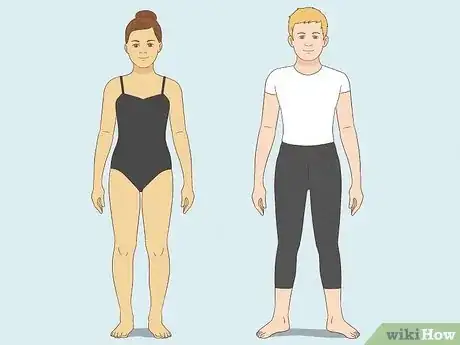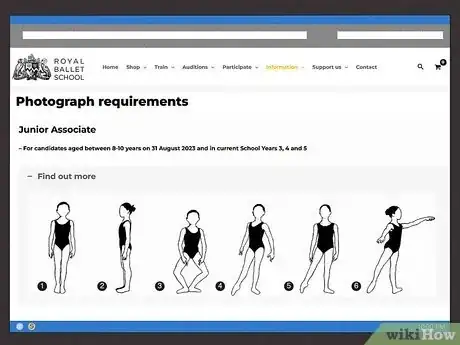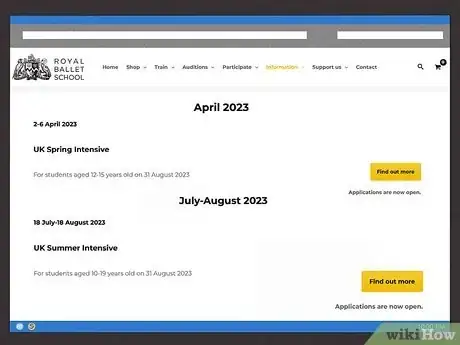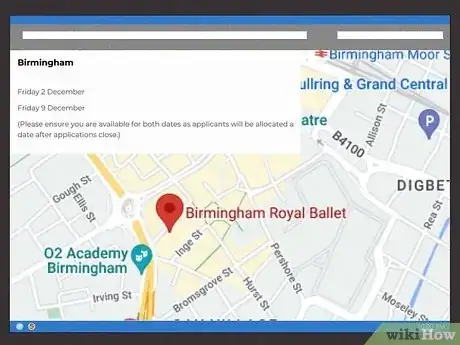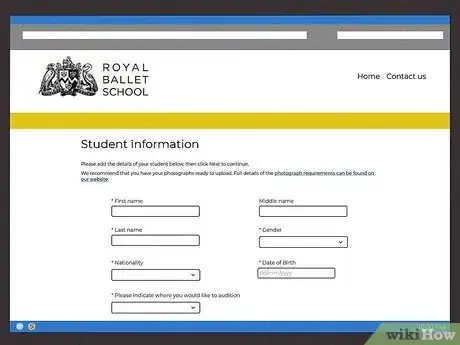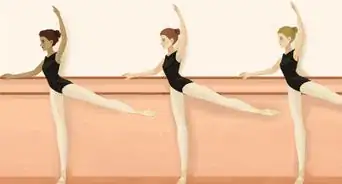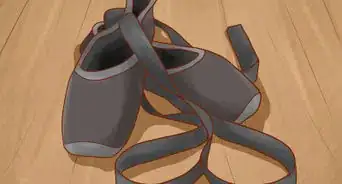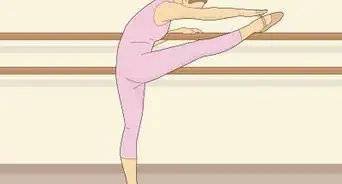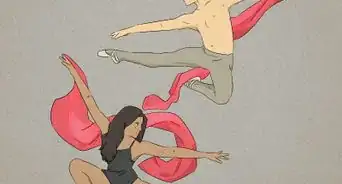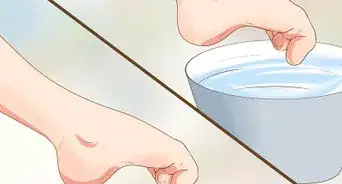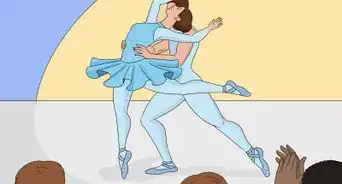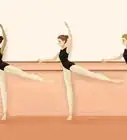This article was co-authored by Geraldine Grace Johns. Geraldine Grace Johns is a Professional Ballerina and the Owner of Grace Ballet in New York and Los Angeles. Geraldine toured through New Zealand, Australia, Japan, and Korea as Jammes in Ken Hill's Original Phantom of the Opera. She has studied with the Royal Academy of Dance in London to become a teacher and taught for the Kudo School of Ballet in Yokohama. Geraldine also ran her own Royal Academy of Dance School in New Zealand before studying at the Neighborhood Playhouse School of the Theatre in New York City. Geraldine was a guest coach and Master Class teacher in Toronto for the Canadian Royal Academy of Dance's Dance Challenge in 2018, 2019, and 2020. She was also a guest coach and Master Class teacher for the USA Royal Academy of Dance Challenge in Long Beach, California in 2019 and 2020. Grace Ballet Los Angeles has won recognition as one of 13 Best Ballet Schools in Los Angeles since opening her school. Geraldine is a contract Practical Teaching Supervisor for the Certificate in Ballet Teaching Studies for the Royal Academy of Dance.
There are 8 references cited in this article, which can be found at the bottom of the page.
This article has been viewed 38,079 times.
The Royal Ballet School’s mission is to prepare dancers to take their place in leading ballet companies. Each class is capped at sixteen students, so the competition is fierce. Many dancers consider it their ultimate goal and a sign that they’ve made it into the ranks of the greats. There’s no way to guarantee a successful audition, but there are ways to help improve your odds.
Steps
Practicing
-
1Take classes. You should start as young as you can. Being older isn’t an insurmountable obstacle. You may sometimes feel like you’re not moving ahead quickly enough, but the time you put in with pay off. If you are advancing well during your training, you may be offered a place to the Royal Ballet Lower School from there. If not, you may still earn entry into a well-known ballet school that will help you move up.
- Start in local ballet schools. They don’t have to be famous to provide your foundational training.
- Practice pre-pointe. Before pointe, you will do pre-pointe for at least a year.
- Remember that any criticism you get from your teachers or coaches is meant to help you improve. Your teachers want you to succeed.
-
2Find a coach. Many successful ballerinas retire and choose to coach other hopefuls.[1] Coaches work one-on-one with dancers and assist them with their weaknesses, so talk to your teachers and the director of the ballet school you’re in. They may point you to a coach that they know can work well with your style, or they may suggest holding off until you’re more advanced.[2]
- Reach out to people you know in the business. Talk to guest instructors or others that you’ve met through your training so far.
- Look for your local accrediting agency for ballet teachers. Depending on where you live, there will be a different agencies. Their websites can help you locate a coach who has the right credentials.
- Try to find a qualified teacher who is registered with a reputable ballet organization, like The Royal Academy of Dance.[3]
Advertisement -
3Take advantage of the Royal Ballet School’s Primary Steps program. For children between the ages of seven and eleven, the Royal Ballet offers a junior school program meant to get you started on your path to success. The program is free, and it provides training from professionals in the field. At the end of the training program, you will be invited to watch a session of Royal Ballet School students.
- Find a local school that offers it. Right now, only 27 schools provide access to the program. These are located in Blackpool, Mansfield Woodhouse, Bury St Edmunds, Swindon, and Dagenham.
- Contact Arts Award. If you are not in one of the areas currently being serviced, you can request information about how to get involved in programs in your area.[4]
Preparing to Apply
-
1Determine which cohort you fit into. Your age as of August 31 is what determines your cohort. Those between eight and eleven apply for the Junior Associates; those between eleven and thirteen apply for the Mid Associates; those between fourteen and fifteen apply for Senior Associates; and those between sixteen and seventeen apply for Advanced Associates. [5] These classes are meant to supplement existing ballet classes.
- Junior Associates (eight through ten years old) is located at eight centers throughout the UK.
- Mid Associates (eleven through thirteen years old) is located at five centers throughout the UK.
- Senior Associates (fourteen and fifteen year olds) only has training locations in London and Birmingham.
- Advanced Associates (sixteen and seven year olds) are trained solely at the Covent Garden location.
- Full-time training is also available to those between the ages of eleven and nineteen. Students sixteen and under attend the campus in Richmond Park. Older students attend the Covent Garden campus.
-
2Attend events held by the Royal Ballet School. These are a great chance for you as a potential students to meet people from the school and talk about your future plans. Insight events are held at various locations to give you a look what to expect if you are accepted.
- Primary and Secondary Insight events are open to potential students between the ages of eleven and sixteen. They allow you to attend a chance to see current students taking classes.
- Junior Insight lets dancers between eight and ten attend a two-hour class typical of what they could expect if they were selected.
- Audition Insight gives you the opportunity to see how the auditions work in an informal setting without stress.
-
3Subscribe to the newsletter. The newsletter is published once per term, and it includes news and updates on the programs. It also lists conferences, exhibits, and events that aspiring students can attend.[6]
-
4Review the classes that you will be able to take. If you know what to expect, then you can start preparing before you even submit your application. Classes for lower level students are simple and include warm up, barre work, and port de bras, while higher levels are expected to take classes in pointe, allegro and repertoire.
-
5Remember to check details. You should spend most of your time preparing for the hard work that you will be taking on, but there are smaller details that you need to keep track of so that your work does not go to waste.
- Check the date for the cut-off. Once it’s past the deadline, no applications will be accepted, regardless of your situation.
Submitting an Application
-
1Get the uniform. For girls, this is a leotard with no skirt or frill, bare feet, and hair groomed into a neat bun for long hair, a neat ponytail for short hair, or a headband for very short hair. For boys, wear a fitted t-shirt, footless tights, and bare feet. You will need the uniform for both the photo session and the audition.
-
2Schedule a photo session. There are specific requirements of which poses must be displayed, and those vary by age and program being applied for. Review the website to find out what you need to do.[7] The school will use the technical facility shown in the photos as part of their admission criteria.
-
3Find the application for the program that you’re interested in. You can apply to the year-long classes or the summer program. The summer program is generally easier to get into due to the larger number of spots. Another benefit to the summer program is that students are often selected from the summer intensive two-week program for the year-long classes.
-
4Find an audition spot. Auditions are held at multiple locations all throughout the UK on various dates, and you must know which venue and date you will be submitting an application for.
-
5Fill out your application. You must go online and visit their website in order to apply. Once the application closes for the year, you cannot access it.
-
6Prepare for the audition. Pre-selection is not necessary for an audition. Anyone who applies can attend the audition class, as long as they are in the proper age range. The audition lasts for up to an hour and a half. It is treated as a class, so you will see demonstrations before you are asked to perform. Summer sessions do not require an audition; students are selected by application and photo only.
- The class includes ballet exercises and physical exercises. It will test your flexibility, creativity, and musicality.
- Audition class size is determined by the size of the studio, but is generally between twenty and thirty applicants.
- Auditions are typically in April or May with decisions returned to you by the end of July.
Expert Q&A
-
QuestionHow can I set myself up for success?
 Geraldine Grace JohnsGeraldine Grace Johns is a Professional Ballerina and the Owner of Grace Ballet in New York and Los Angeles. Geraldine toured through New Zealand, Australia, Japan, and Korea as Jammes in Ken Hill's Original Phantom of the Opera. She has studied with the Royal Academy of Dance in London to become a teacher and taught for the Kudo School of Ballet in Yokohama. Geraldine also ran her own Royal Academy of Dance School in New Zealand before studying at the Neighborhood Playhouse School of the Theatre in New York City. Geraldine was a guest coach and Master Class teacher in Toronto for the Canadian Royal Academy of Dance's Dance Challenge in 2018, 2019, and 2020. She was also a guest coach and Master Class teacher for the USA Royal Academy of Dance Challenge in Long Beach, California in 2019 and 2020. Grace Ballet Los Angeles has won recognition as one of 13 Best Ballet Schools in Los Angeles since opening her school. Geraldine is a contract Practical Teaching Supervisor for the Certificate in Ballet Teaching Studies for the Royal Academy of Dance.
Geraldine Grace JohnsGeraldine Grace Johns is a Professional Ballerina and the Owner of Grace Ballet in New York and Los Angeles. Geraldine toured through New Zealand, Australia, Japan, and Korea as Jammes in Ken Hill's Original Phantom of the Opera. She has studied with the Royal Academy of Dance in London to become a teacher and taught for the Kudo School of Ballet in Yokohama. Geraldine also ran her own Royal Academy of Dance School in New Zealand before studying at the Neighborhood Playhouse School of the Theatre in New York City. Geraldine was a guest coach and Master Class teacher in Toronto for the Canadian Royal Academy of Dance's Dance Challenge in 2018, 2019, and 2020. She was also a guest coach and Master Class teacher for the USA Royal Academy of Dance Challenge in Long Beach, California in 2019 and 2020. Grace Ballet Los Angeles has won recognition as one of 13 Best Ballet Schools in Los Angeles since opening her school. Geraldine is a contract Practical Teaching Supervisor for the Certificate in Ballet Teaching Studies for the Royal Academy of Dance.
Professional Ballerina & Ballet Instructor Take every opportunity to perform on stage, take extra classes, and practice daily. Also, be very careful and respectful with your body—it is your tool, and you need to remain injury-free and healthy.
Take every opportunity to perform on stage, take extra classes, and practice daily. Also, be very careful and respectful with your body—it is your tool, and you need to remain injury-free and healthy. -
QuestionWhat if I still can't do the splits and I don't get in?
 Community AnswerFirst of all go down as far as you can then stretch from there. My old dance teacher said it is easier to practice your splits in the bathtub and it really does help. Spend about 10 to 15 mins every day stretching and eventually, you will get there.
Community AnswerFirst of all go down as far as you can then stretch from there. My old dance teacher said it is easier to practice your splits in the bathtub and it really does help. Spend about 10 to 15 mins every day stretching and eventually, you will get there. -
QuestionHow can I get into ballet schools that do not often accept people of color?
 Buggylu25Top AnswererDon't let this get in your way! It never hurts to audition. If you feel that you've been denied acceptance solely on a basis of discrimination, bring it to the school's attention. Dance is a universal art that is open to all, so try not to let a fear of rejection based on a school's history stop you!
Buggylu25Top AnswererDon't let this get in your way! It never hurts to audition. If you feel that you've been denied acceptance solely on a basis of discrimination, bring it to the school's attention. Dance is a universal art that is open to all, so try not to let a fear of rejection based on a school's history stop you!
Warnings
- There is a huge difference between being at the top of your school to being the bottom of the company at the Royal Ballet Academy. You will need to prove yourself and get noticed by the teachers if you want to keep advancing. [8]⧼thumbs_response⧽
References
- ↑ http://www.telegraph.co.uk/culture/theatre/dance/8926160/The-life-of-a-Royal-Ballet-dancer.html
- ↑ http://pointemagazine.com/inside-pt/issuesaprilmay-2013private-lesson-debate/
- ↑ Geraldine Grace Johns. Professional Ballerina & Ballet Instructor. Expert Interview. 20 May 2021.
- ↑ http://www.artsaward.org.uk/site/?id=64
- ↑ https://www.royalballetschool.org.uk/train/apply/
- ↑ https://www.royalballetschool.org.uk/train/
- ↑ https://www.royalballetschool.org.uk/train/apply/photograph-requirements/
- ↑ http://www.telegraph.co.uk/culture/theatre/dance/8926160/The-life-of-a-Royal-Ballet-dancer.html
About This Article
It takes a lot of perseverance to get into the Royal Ballet School, since each class contains only 16 students, but if you dedicate yourself to practice and have a successful audition, you may be able to get in! Start taking ballet classes as young as you can, and find a coach who can help you perfect your technique. If you’re between the ages of 7 and 11, you can also take advantage of the Royal Ballet School’s Primary Steps program, which offers free ballet training from professionals in the field. To learn how to apply to the Royal Ballet School, read on!
